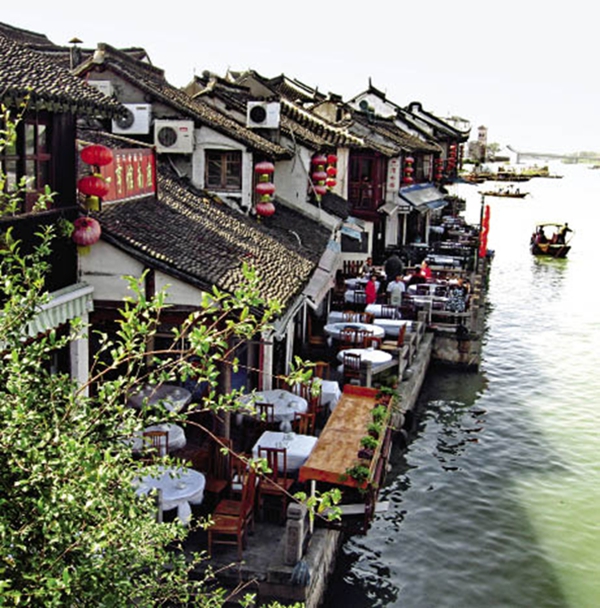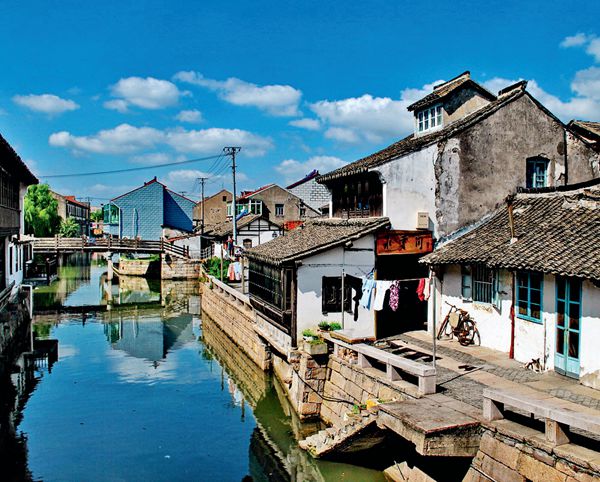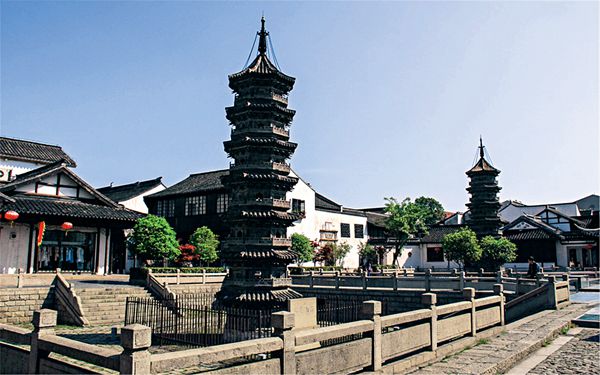Located in the Yangtze River Delta near Jiangsu and Zhejiang provinces, Shanghai is site of many ancient water towns. Famous for their beautiful scenery, the soft Suzhou dialect, and folk customs, these towns exemplify the idyllic image of “slender bridges, a meandering river and well aligned cottages.”
Zhujiajiao
Situated in Qingpu District of western Shanghai, Zhujiajiao is one of the city’s four famous towns. It not only offers beautiful natural scenery, such as the Dianshan Mountain and Dianshan Lake, but also striking man-made wonders. The town features rivers and harbors, nine streets along river banks, 36 stone bridges, and abundant Ming and Qing Dynasty architectures. Historical records show that Zhujiajiao has been in existence since the Song (960-1279) and Yuan (1271-1368) dynasties. Ancient buildings such as Yuanjin Temple and Cimen Temple were built in the Yuan Dynasty. Waterways bisecting the town provide convenient transportation and nurture businesses.

On the north bank of the Caogang River is Jingting Port, on the south bank a bustling business street. Zigzagging lanes of granite and black tiles originating in the Ming and Qing dynasties run along both banks. Extending for several kilometers and site of hundreds of stores, North Street was one of the busiest in the region south of the Yangtze River. The 200-year-old City God Temple features blue bricks and yellow walls, roof decorations in the shape of flying dragons, and lattice windows that add particular charm to the buildings. The Xi’s (a local prominent clan) Hall is ornamented with skillful carvings and ornate flower patterns. With houses on all sides, on reaching what appears to be the end of the road, you find yourself at a junction with another new road, and more architectural delights.
Transport: Take subway Line 2 to Xujing Station and transfer to Line Zhuxu.
Fengjing
Located in Jinshan District, southwestern Shanghai, 1,500-year-old Fengjing Ancient Town is the main gateway connecting Shanghai with Southwest China. The town has many rivers, and is famous for its bridges, temples and alleys, as well as famous personages. Zhihe Bridge, one of the town’s 52, is around 700 years old. Ancient buildings mostly situated on the Heping, Shengchan, North, and Youhao Streets, are well preserved. Fengjing Ancient Town is moreover birthplace of Jinshan farmers’ paintings. Folk arts, like blue printed fabric, carved furniture, festive lantern making, papercutting, embroidery, and knitting, have a long history.

Transport: Take subway Line 1 to Jinjiang Park Station and take exit 1. Take bus Line Fengmei to Fengjingpailou Station.
Xinchang
Thirty-six kilometers from the city center, Xinchang Ancient Town is in Nanhui District of southeastern Shanghai. It became well known after Ang Lee’s Lust Caution was filmed there. The old town features traditional residential buildings, stores, narrow alleys and a teahouse reputed as “the best of regions south of the Yangtze River.” Houses along the river were originally the abodes of wealthy and influential families. The town is famous for its many memorial archways, built to honor achievements in feudal society of benevolent governance, loyalty, and filial piety, and arched bridges, which complete the traditional image of a water town. Qianqiu Bridge is Xinchang’s most well-known arched bridge. The camphor trees surrounding the bridge balustrades cast cool, fragrant shadows.

Transport: Take the Hunan or Longda bus line from Pudong.
Nanxiang
The 1,000-year-old Nanxiang Town, located in Jiading District in northwestern Shanghai, is one of the best-known ancient towns in regions south of the Yangtze River. Legend has it that it was originally a remote village. One day local farmers found a big rock, and as they dug it out, two white cranes flew towards and roosted on it. Deqi, a local monk, believed that this signified an ideal Buddhist site, and built a temple there using donations from local devotees. When the temple was completed, the cranes flew south. Both the temple and village thus became known as Nanxiang (fly south). The Nanxiang steamed stuffed bun, with a history of more than 100 years, is the most popular local specialty. Its filling is made from a secret recipe passed down from masters to their apprentices. In the shape of a pagoda, the scrumptious Nanxiang steamed bun has a thin wrapping and a juicy meat filling.

Transport: Take subway Line 11.
Compiled and edited by China Today




